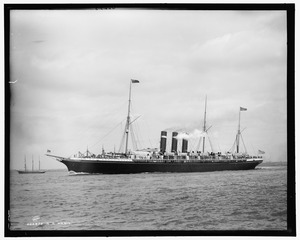SS City of Paris (1888)

SS Paris (ex City of Paris) in the mid 1890s
|
|
| History | |
|---|---|
|
|
|
| Name: | SS City of Paris |
| Owner: | Inman Line (later International Navigation Company) |
| Route: | Atlantic crossing. |
| Builder: | J & G Thomson of Clydebank, Scotland |
| Cost: | $1,850,000 |
| Yard number: | 241 |
| Launched: | 20 October 1888 |
| Maiden voyage: | 3 April 1889 |
| Fate: | merged into American Line in 1893 |
|
|
|
| Name: | SS Paris |
| Owner: |
|
| Route: | Atlantic crossing. |
| Renamed: |
|
| Fate: | Scrapped at Genoa, Italy in 1923 |
| General characteristics | |
| Type: | Steamship |
| Tonnage: |
|
| Length: | 560 ft (170 m) |
| Beam: | 63 ft (19 m) |
| Installed power: | 18,000hp (20,880kW) |
| Propulsion: | Triple expansion reciprocating steam engines, twin propellers. |
| Speed: | 20.0 knots (37.0 km/h; 23.0 mph) |
| Complement: | 1740 passengers |
| Crew: | 362 Officers and crew |
City of Paris, was a British-built passenger liner of the Inman Line that held the Blue Riband as the fastest ship on the north Atlantic route from 1889 to 1891 and again from 1892 to 1893. A sister ship of the City of New York and a rival of the White Star Line Teutonic and Majestic, she proved to be the quickest of the pre-Campania twin-screw express liners. In 1893, she was renamed Paris and transferred to US registry when the Inman Line was merged into the American Line. She and her sister were paired with the new American built St Louis and St Paul to form one of the premier Atlantic services: known as the "big four". Paris served the US Navy as the auxiliary cruiser Yale during the Spanish American War and is remembered for slipping into the harbor at San Juan, Puerto Rico under the Spanish guns of Morro Castle. After Paris returned to commercial service, she was seriously damaged in 1899 when she grounded on The Manacles off the British coast. Rebuilt and renamed Philadelphia, she sailed for the American Line until requisitioned again during World War I as the transport Harrisburg. After the war, she continued with the American Line until 1920 and was scrapped in 1923.
In 1886, the UK flagged Inman Line became bankrupt and was taken over by its largest creditor, the Philadelphia-based International Navigation Company. The firm's Vice President, Clement Griscom immediately sailed to Liverpool with a commitment from the Pennsylvania Railroad to provide $2 million in capital towards the building of a new ship to compete against Cunard and White Star. Scottish shipbuilders were suffering a recession and proposed construction of two identical ships at the discounted price of $1,850,000 apiece. The Pennsylvania Railroad agreed to finance the second ship that became the City of Paris.
...
Wikipedia
